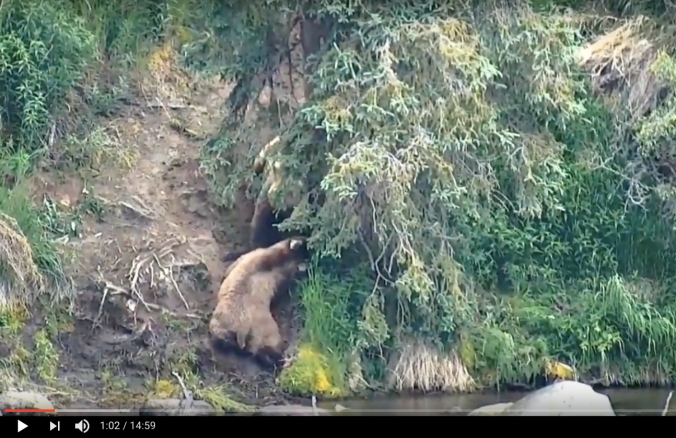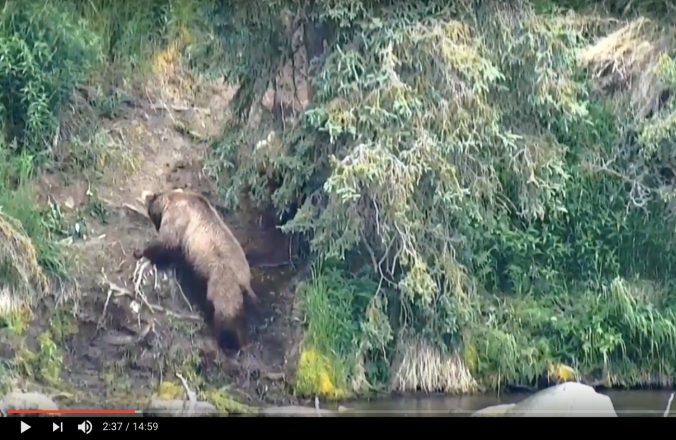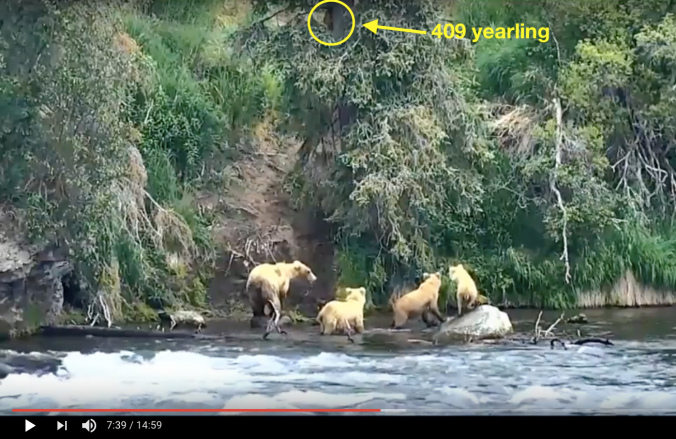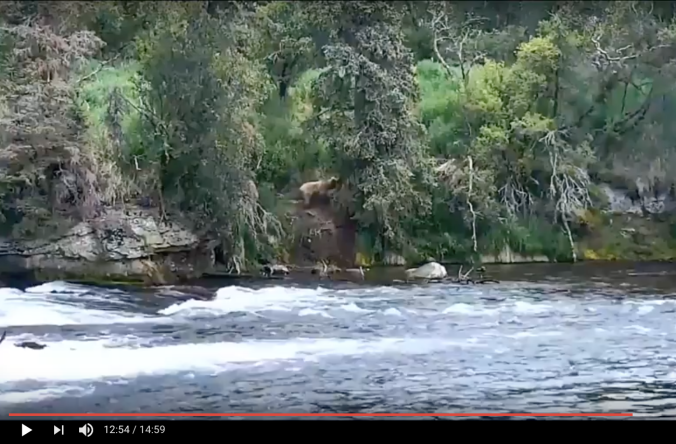Last summer, 128 Grazer and 409 Beadnose found themselves face to face in defense of their cubs . Recently on bearcam, they had another dustup. This one was unique and included elements I had never observed before.
When we ask, “Why did that bear behave like that?” we should ask two additional questions.
- Was the bear motivated by food or potential access to food?
- Was the bear motivated by sex or reproductive success?
Biology can be distilled simplistically into two categories: food and sex. Adequate nutrition is necessary for survival of the individual, and since bears hibernate throughout much of the year they are particularly motivated by food. Reproduction also drives bears to behave in particular ways. We should also consider how each bear’s disposition influences their behavior.
128 Grazer
As a young adult bear, 128 Grazer became very skilled at fishing the lip of the falls. She’d compete for access to that spot with several other adult males and females. As a single bear (i.e. no cubs), she was fairly tolerant of other bears in close proximity. After 128 became a mother in 2016 though, her behavior became increasingly defensive. She didn’t shy away from confronting larger adult males in order to protect her cubs .
Still caring for three yearlings in 2017, she seems to be just as protective and wary as last year.
409 Beadnose
In contrast to Grazer, 409 Beadnose is an experienced mother who has weaned three litters (her current batch of yearlings is her fourth known litter). Beadnose can be defensive too, but tends to avoid confrontation more often than 128. While Grazer visited the falls with her spring cubs last summer, 409 did not. This is a clear behavioral change for Beadnose, because she visits the falls frequently when she’s not caring for cubs.

128 Grazer (left) and 409 Beadnose are familiar with each other and often use the same areas to fish.
Now both of these mothers are raising yearlings, both have returned to Brooks Falls, and both tend to fish the same places (the lip or the far pool). Most importantly, both are competing for the same resources in order to successfully raise their cubs—leading to situations like this.
Can this apparent snafu be explained by a motivation for food or reproductive success? When the video begins, 409 Beadnose is ascending the hill. 128 Grazer is the blonder bear standing under the spruce tree. Grazer refuses to yield to Beadnose’s approach. The bears jaw and growl at each other, while 128’s yearlings remain in the spruce tree above their mom.

Beadnose seems compelled to get up the hill and skirts Grazer. There are other routes available, but she sticks with this one.

Grazer’s cubs eventually come down from the tree while Beadnose lingers in the forest nearby. Something keeps Beadnose from moving farther away, but at this point we can’t see her.

With 409 still on the hill, Grazer and cubs move down to the river. Shortly afterward her yearlings react to something in the same tree they had just climbed down from. Grazer begins to jaw pop, a loud and distinctive warning noise. We can see movement in the spruce tree above.

It’s one of Beadnose’s cubs.

Grazer and her yearlings scramble up the hill just 409’s yearling tries to climb down. Now we understand why Beadnose didn’t give Grazer more space previously and why Beadnose remained in the forest near spruce tree—one of her cubs was in the same tree as Grazer’s cubs! This is something I never witnessed before, cubs from two litters in the same tree at the same time.
409 is mostly out of sight as 128 and cubs run up the hill. 409’s yearling though, is unable to get out of the tree.

A short stand-off ensues. 409’s yearling remains in the tree, 409 stands not far up the hill, and 128 Grazer and yearlings remain close by.

When 409’s cub tries to climb down again, Grazer reacts and charges to the base of the tree.

Grazer then climbs the tree, forcing Beadnose’s yearling back up. About ninety seconds later, 128 has moved farther away, which allows 409’s cub to climb out of the tree and rejoin its mother.
This interaction between Grazer and Beadnose was unique because cubs from two different litters were in the same tree at the same time, greatly complicating a situation where the families could’ve avoided each other. The interaction was ordinary however, because both Beadnose’s and Grazer’s behavior seemed to be motivated by an urge to protect their cubs. Grazer’s defensiveness is easily triggered and she must’ve viewed the 409 yearling as a threat, which in my opinion led her to chase it back up the tree. Beadnose may have realized Grazer was willing to physically fight in this situation. This could’ve deterred Beadnose from standing next to the tree under her cub. At the beginning of the video, Beadnose also couldn’t get her cub out of the tree with Grazer’s cubs still in it. Stuck in a Catch-22, Beadnose seemed to choose a more cautious tactic: move slightly away and wait.
Motivation for food or reproductive success explains quite a lot in biology, but not all bear behavior can be explained so simplistically (why would a bear play with her foot? ). The prolonged interaction between these families however, does fit one of the biological motivators. This interaction probably wasn’t hierarchical; that is, it wasn’t about asserting dominance for access to food and mates. It was about protecting offspring. In other words, it was about reproduction.
Thank you Mike for explaining these Mom’s behavior. I was thinking the entire
time that all 5 cubs were in that tree, but you’re right it was just one of Beads. Wouldn’t you love to have
been able to see how the cubs reacted to each other in the tree? Beadies other one must have been
in another tree up there. I’m worried about Grazer and her cubs if she continues to be so aggressive. She couldn’t be much worse than last year though. She went at poor old Otis at a run while he was sitting there minding his own business. I felt bad for him, took him a while to work up the nerve to go back. And attacked the big boys. Take care Mike. Thank you for all you do. We love your thoughts.
JeanneB in Chat
LikeLike
It’s possible that both of 409’s cubs were in the tree. I couldn’t tell by watching the video.
128 is defensive, maybe more so than many of the mother bears we see on the river, but this isn’t abnormal and it may be advantageous. While the larger male bears can overpower her if they want, they’d also risk serious injury in doing so. That might be why 83 didn’t fight back much when 128 attacked him last year.
LikeLiked by 1 person
ty much mike for this summary!! as you and Ranger Roy teached us, Nature and bears always can surprise us with behaviour the humans dont think about!!
LikeLiked by 1 person
Thanks Mike. This was very interesting to watch the whole situation. I too, like jadensgranny, thought a second Beadnose cub was up the tree and eventually came down. The videos were very helpful. Thank you for continuing to enlighten us!
LikeLiked by 1 person
There could’ve been a second cub in the tree. I just wasn’t able to see it in the video.
LikeLiked by 1 person
Outstanding coverage of a confusing situation! Thank you Mike!
LikeLike
Pingback: Bear Cam Week in Review | Explore